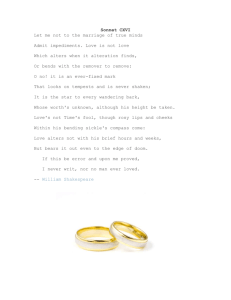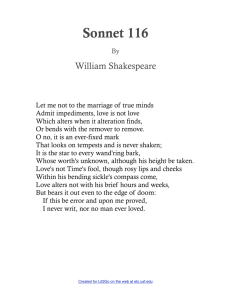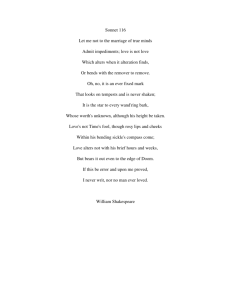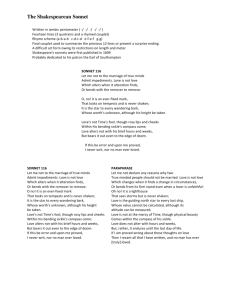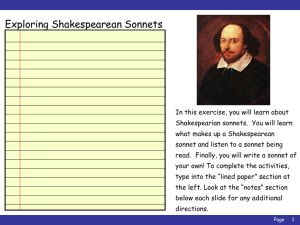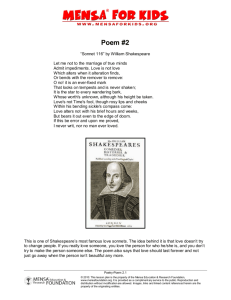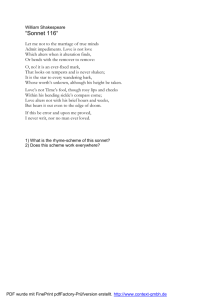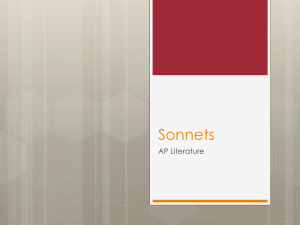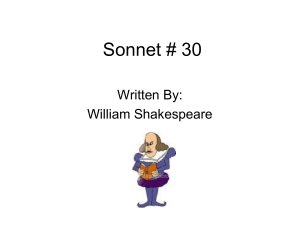love - Oncourse
advertisement
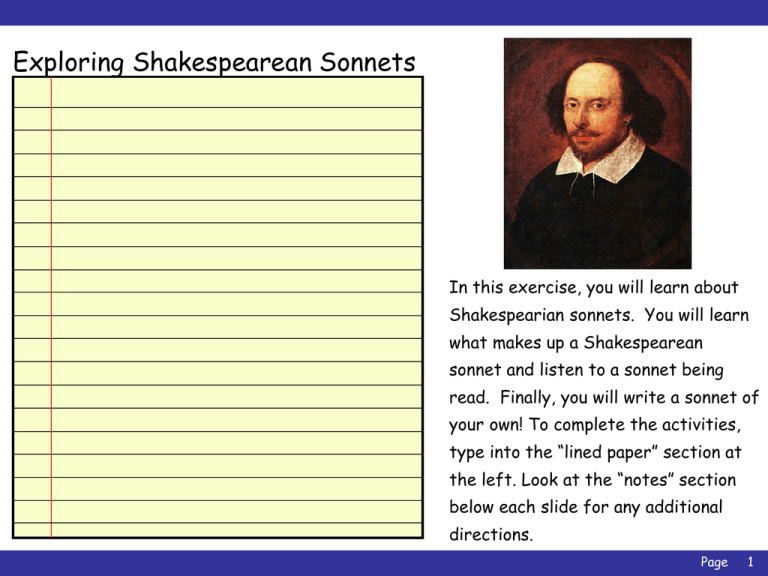
Exploring Shakespearean Sonnets In this exercise, you will learn about Shakespearian sonnets. You will learn what makes up a Shakespearean sonnet and listen to a sonnet being read. Finally, you will write a sonnet of your own! To complete the activities, type into the “lined paper” section at the left. Look at the “notes” section below each slide for any additional directions. Page 1 What makes a Shakespearean sonnet? Let me not to the marriage of true minds Admit impediments. Love is not love Which alters when it alteration finds, Or bends with the remover to remove: O, no! it is an ever-fixed mark, That looks on tempests and is never shaken; It is the star to every wandering bark, Whose worth's unknown, although his height be taken. A sonnet is a poem composed of 14 lines with a specific rhyme scheme. A Shakespearean sonnet contains three sets of four lines (quatrains) and one set of two lines (couplet). Love's not Time's fool, though rosy lips and cheeks Within his bending sickle's compass come; Love alters not with his brief hours and weeks, But bears it out even to the edge of doom. If this be error and upon me proved, I never writ, nor no man ever loved. Page 2 What makes a Shakespearean sonnet? Let me not to the marriage of true minds Admit impediments. Love is not love Which alters when it alteration finds, Or bends with the remover to remove: O, no! it is an ever-fixed mark, That looks on tempests and is never shaken; It is the star to every wandering bark, Whose worth's unknown, although his height be taken. A Shakespearean sonnet has a rhyme scheme of ABAB CDCD EFEF GG. Each letter corresponds to a different sound at the end of the line. This means that all lines with a letter “A” end in the same sound, or they rhyme. The same is true for each letter. Love's not Time's fool, though rosy lips and cheeks Within his bending sickle's compass come; Love alters not with his brief hours and weeks, But bears it out even to the edge of doom. If this be error and upon me proved, I never writ, nor no man ever loved. Page 3 What makes a Shakespearean sonnet? Let me not to the marriage of true minds Admit impediments. Love is not love Which alters when it alteration finds, Or bends with the remover to remove: O, no! it is an ever-fixed mark, That looks on tempests and is never shaken; It is the star to every wandering bark, Whose worth's unknown, although his height be taken. Love's not Time's fool, though rosy lips and cheeks Within his bending sickle's compass come; Love alters not with his brief hours and weeks, But bears it out even to the edge of doom. Finally, a Shakespearean sonnet is written in a rhythm called iambic pentameter. This means that each line contains five pairs of syllables, an unstressed syllable followed by a stressed syllable. You might think of iambic pentameter as a heartbeat, the unstressed syllables being the “lub” and the stressed syllables the “DUB” : lub-DUB lub-DUB. If this be error and upon me proved, I never writ, nor no man ever loved. Page 4 Lend me your ears! Let me not to the marriage of true minds Admit impediments. Love is not love Which alters when it alteration finds, Or bends with the remover to remove: O, no! it is an ever-fixed mark, That looks on tempests and is never shaken; It is the star to every wandering bark, Whose worth's unknown, although his height be taken. Click on the image below to hear a reading of Shakespeare's Sonnet #116. Listen closely and see if you can identify the rhyme and rhythm that of the Shakespearean sonnet. Love's not Time's fool, though rosy lips and cheeks Within his bending sickle's compass come; Love alters not with his brief hours and weeks, But bears it out even to the edge of doom. If this be error and upon me proved, I never writ, nor no man ever loved. Page 5 Now it's your turn! Remember, a Shakespearean sonnet has: •14 lines—3 quatrains and a couplet. •ABAB CDCD EFEF GG rhyme. •Iambic pentameter. Page 6
